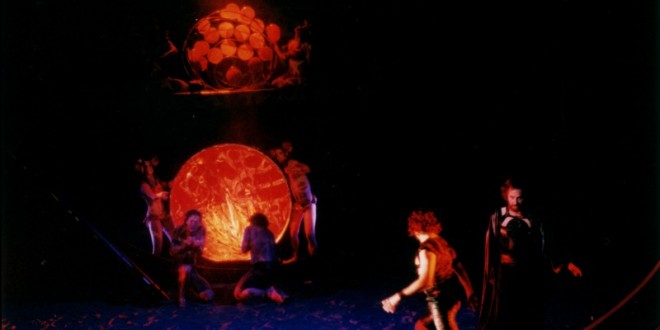| "Lotus Eaters" From The Odyssey - Zen Zen Zo 2005 | |
|---|---|
| Play | |
| Links | |
This piece was written for Zen Zen Zo's 2004 production of The Odyssey, performed at the the Queensland Performing Arts Centre. The scene depicts the encounter between the sailors of Ulysses (Odysseus) and the narcotic plants in the Country of the Lotus Eaters. Director Simon Woods indicated that he wanted to portray the drug induced stupor of the sailors, but retain the sense of a danger or threat. The act of taking the narcotic lotus was shown popping balloons with flour in them, releasing a cloud of powder. I thought that the primary colour of the music should be orange. This colour ended up being predominant in the lighting as well, but I think this was coincidence, I don't recall discussing it with the lighting designer, although Simon may have passed this idea to him.
I began the piece with the water elements with the flanging effect and it's attendant roaring bassy reflection. The sea remains present throughout, reminding us of the sailor's true mission. The falling vocal melody which is first clearly heard at around 50 seconds uses samples including a delay in a lower octave, and synthesis elements. Next came the tabla, programmed from individual hits from the EastWest "Ra" library, which were specifically introduced to give an exotic feel. I have used these tabla rhythms as the modulator in a vocoder system in the later half of the piece. It gradually introduces a tonal pulse with a strong fifth at around 2 minutes and becomes the predominant rhythmic element around 2:30. The tabla never disappear but their function changes through this technique from a purely rhythmic driver to one of more tonal purpose.
Several techniques have been used to smear the definitions between a musical event and a "sonic" event. One of these involves time stretching, reversing and tonal convolution. The latter of these involves imposing the sonic characteristics of one sound upon the other. The technique is most often used to apply "real" reverbs recorded as impulse responses, but here I have used tonal and pitch-moving sounds. The result is a smearing of pitch and tonal characteristics. This can be heard in the very opening seconds, where a short loop of sitar has been passed through a bell sample in AudioEase Altiverb. The twanging of the sitar can be heard evolving into a long, resonant tone that does not dissipate until around 19 seconds. I found myself constantly adding tones and elements, such as the "guitar feedback" tone at around 1:40 and 4:00.
Overall the piece has a strong mid range tonal centre, with minimal bass. I did not create a bass part as I felt that the piece "floated" without one and has a sense of timelessness that I associate with trance. This was certainly a piece that I got myself lost in the creation, particularly the rhythms and sense of popping notes from the vocoder. I am reminded somewhat of the "relaxation music" I was commissioned to write in the mid 90s. These pieces were similar in that they were also very busy, but provide something of an undulating, glassy surface of 16ths on which to float. Perhaps this is a reflection of a busy mind.
Related Posts
- Macbeth by Fax: My first collaborative piece with Zen Zen Zo was created long distance, mostly through written communication by fax.
- Being there: Families and friends stand or fall by their unity.
- I do this because ...: Academic pursuits are never the whole picture. There are personal reasons for engaging in this research.
- Earworms: When you just can't get that Rhianna song out of your head all the way to work, you have an Earworm. When Rhianna stays for a week, you have a problem.
- Tell me is this Real Life?: Tell me, is this real life or is it just an effect?
- Theatrics: The theatre has been a school of meaning-making. Layer on layer of elements to the same end.
